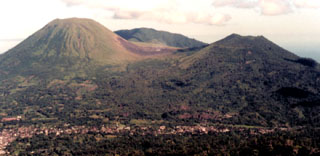Report on Lokon-Empung (Indonesia) — 30 January-5 February 2013
Smithsonian Institution / US Geological Survey
Weekly Volcanic Activity Report, 30 January-5 February 2013
Managing Editor: Sally Sennert.
Please cite this report as:
Global Volcanism Program, 2013. Report on Lokon-Empung (Indonesia) (Sennert, S, ed.). Weekly Volcanic Activity Report, 30 January-5 February 2013. Smithsonian Institution and US Geological Survey.
Lokon-Empung
Indonesia
1.358°N, 124.792°E; summit elev. 1580 m
All times are local (unless otherwise noted)
According to news articles, Lokon-Empung erupted twice on 31 January, producing an ash plume that rose 800 m after the first eruption. Seismicity had increased the day before. In another article the head of the Lokon observation post reported that eruptions from Lokon occurred daily, and specifically that nine eruptions had occurred on 2 February.
Based on a ground report from CVGHM, the Darwin VAAC reported that an ash plume from Lokon-Empung rose to an altitude of 4 km (13,000 ft) a.s.l. on 3 February. Ash was not detected in satellite imagery.
Geological Summary. The Lokong-Empung volcanic complex, rising above the plain of Tondano in North Sulawesi, includes four peaks and an active crater. Lokon, the highest peak, has a flat craterless top. The morphologically younger Empung cone 2 km NE has a 400-m-wide, 150-m-deep crater that erupted last in the 18th century. A ridge extending 3 km WNW from Lokon includes the Tatawiran and Tetempangan peaks. All eruptions since 1829 have originated from Tompaluan, a 150 x 250 m crater in the saddle between Lokon and Empung. These eruptions have primarily produced small-to-moderate ash plumes that sometimes damaged croplands and houses, but lava-dome growth and pyroclastic flows have also occurred.
Sources: People's Daily Online (China), Darwin Volcanic Ash Advisory Centre (VAAC), Kompas.com

